
Centaurea is a genus of over 700 species of herbaceous thistle-like flowering plants in the family Asteraceae. Members of the genus are found only north of the equator, mostly in the Eastern Hemisphere; the Middle East and surrounding regions are particularly species-rich. In the western United States, yellow starthistles are an invasive species. Around the year 1850, seeds from the plant had arrived to the state of California. It is believed that those seeds came from South America.
Iberica, a Latin word referring to the Iberian Peninsula, may refer to:

Peucedanum ostruthium or Imperatoria ostruthium, masterwort, is a species of flowering plant in the family Apiaceae. It is native to the mountains of Central and Southern Europe, but has been widely introduced outside its native range.

Centaurea calcitrapa is a species of flowering plant known by several common names, including red star-thistle and purple starthistle. It is native to Europe but is rarely found there, it is known across the globe as an introduced species and often a noxious weed. The species name calcitrapa comes from the word caltrop, a type of weapon covered in sharp spikes.

Centaurea solstitialis, the yellow star-thistle, is a member of the family Asteraceae, native to the Mediterranean Basin region. The plant is also known as golden starthistle, yellow cockspur and St. Barnaby's thistle The plant is a thorny winter annual species in the knapweed genus.
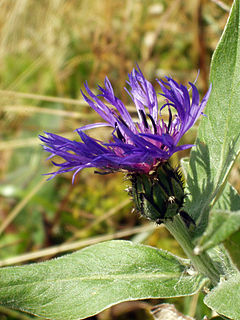
Centaurea montana, the perennial cornflower, mountain cornflower, bachelor's button, montane knapweed or mountain bluet, is a species of flowering plant in the daisy family Asteraceae, endemic to Europe. It is widespread and common in the more southerly mountain ranges of Europe, but is rarer in the north. It escapes from gardens readily, and has thereby become established in the British Isles, Scandinavia and North America. This plant has become an invasive species in British Columbia, Canada.
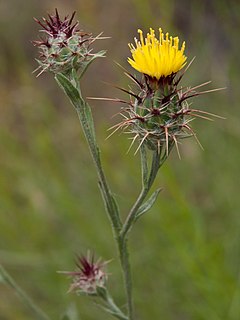
Centaurea melitensis is an annual plant of the Asteraceae, 1 to 11 decimetres high, with resin-dotted leaves and spine-tipped phyllaries. This plant is native to the Mediterranean region of Europe and Africa. It was introduced to North America in the 18th century; the first documented occurrence in California is in the adobe of a building constructed in San Fernando in 1797. It is also naturalized on a number of Pacific islands.
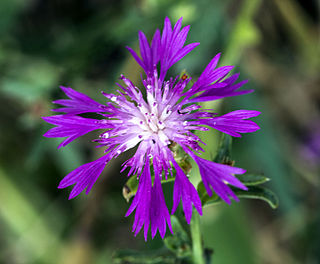
Centaurea diluta, the lesser star-thistle or North African knapweed, is a species of Centaurea. It is native to southwestern Europe and northern Africa.

Centaurea jacea, brown knapweed or brownray knapweed, is a species of herbaceous perennial plants in the genus Centaurea native to dry meadows and open woodland throughout Europe. It grows to 10–80 centimetres (4–31 in) tall, and flowers mainly from June to September.
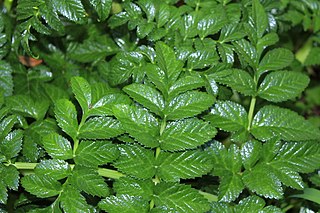
Angelica pachycarpa, the Portuguese angelica, is a herbaceous perennial plant native to north western Spain and western Portugal, and naturalized in New Zealand. It inhabits forests, grasslands and stream sides and is occasionally grown as an ornamental garden subject for its glossy foliage and umbels of white flowers.

Quercus pyrenaica, commonly known as Pyrenean oak, is a tree native to southwestern Europe and northwestern North Africa. Despite its common name, it is rarely found in the Pyrenees Mountains and is more abundant in northern Portugal and north and northwestern Spain.

Davallia canariensis, the hare's-foot fern, is a species of fern in the family Davalliaceae. It is endemic to Macaronesia and the Iberian Peninsula. It grows well in a sunny atmosphere and amongst rocks.
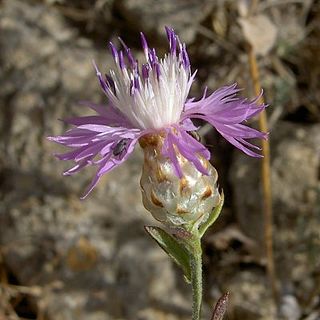
Centaurea alba is a species of Centaurea found in the Iberian Peninsula in southern and central Spain and in a small neighbouring area in the interior of Portugal. There are three recognised subspecies, and of one subspecies, the nominate, there are furthermore three varieties.
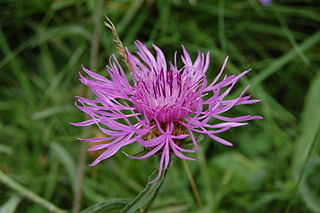
Centaurea aspera, the rough star-thistle, is a species of Centaurea found in Europe and in New York, United States.

Centaurea stoebe, the spotted knapweed or panicled knapweed, is a species of Centaurea native to eastern Europe. It is also an invasive species in southern Canada, and northwestern Mexico, and nearly every state in the United States; it has thrived in the western United States in particular, much of which has a dry climate similar to the Mediterranean. This species and Centaurea diffusa are tumbleweeds — plants that break free of their roots and tumble in the wind, facilitating the dispersal of their seeds.

Centaurea paniculata, the Jersey knapweed, is a species of Centaurea found in France and northern Italy.
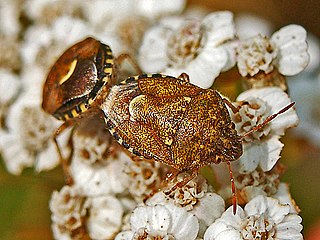
Staria lunata is a species of shield bug belonging to the family Pentatomidae. It is the only species of the genus.

Rhaponticoides is a genus of flowering plants in the family Asteraceae, found in northern Africa, southern and eastern Europe, and western Asia as far east as Mongolia. They were resurrected from Centaurea.

Chlorsulfuron is an ALS inhibitor herbicide, and is a sulfonylurea compound. It was discovered by George Levitt in February of 1976 while working at DuPont, which was the patent assignee.


















